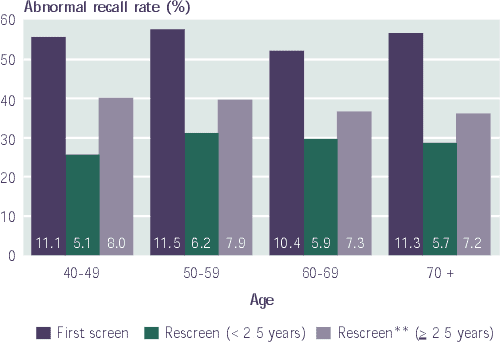Common menu bar links
Institutional links
Diseases & Conditions
Health & Safety
Research & Statistics
Agency Information
Search Box
E-mail this page
Results of Screening
Organized breast cancer screening aims to ensure that all breast cancers are identified in asymptomatic women while minimizing the number of healthy women who experience unnecessary follow-up procedures.
Abnormal recall rates on first screen are normally high, reflecting prevalent cancers among screened women. Abnormal recall rates differed little among age groups, ranging from 10.4% to 11.5% of first screens (Table 4). For rescreens occurring less than 2.5 years from the previous screen, the abnormal recall rate was substantially lower (between 5.1% and 6.2%) (Figure 9). The lower rate may reflect either the value of having previous comparison mammograms or the likelihood that fewer cancers would develop between screens or both factors. The abnormal recall rates for rescreens occurring at least 2.5 years after the previous screen start to revert back towards the rates at first screen. This emphasizes the benefits of returning for a subsequent screen in a timely fashion.
|
Figure 9 |
 |
|
*Includes mammography and clinical breast examination as screening
modalities. |
The rate of abnormal
screens was slightly higher for first screens in comparison with
standards set by other national breast screening programs (see
Appendix 1), which specify
that fewer than 7% to 10% of first screens should be abnormal.
However, these programs use mammography as the sole modality of
screening, whereas several Canadian programs also use clinical
breast examination (CBE). For women aged 50 to 69, CBE alone
accounted for approximately 12% to 17% of the abnormal screens and
5% to 7% of cancers detected. For women aged 50 to 69, the rate of
abnormalities detected by mammography alone are within standards
set by the UK and Australian programs for first screen, and within
the UK standard for rescreens. In general, Canadian recall rates
just slightly exceed the standards set by Sweden and Europe.
|
Table 4 |
|||||
|
Mode of Detection |
40-49 |
50-59 |
60-69 |
70+ |
All Ages |
|
Abnormal by mammography alone |
|
|
|
|
|
|
Abnormal by both mammography and CBE* |
|
|
|
|
|
|
Abnormal by CBE* alone |
|
|
|
|
|
|
All modes of detection |
|
|
|
|
|
|
* Manitoba, Ontario, Nova Scotia, and Newfoundland provide CBE by a nurse or technologist; of these programs, all but Nova Scotia restrict program participation to women aged 50 and older. Note: Data for the New Brunswick program are incomplete and therefore do not comprehensively reflect program activity. |
|||||
